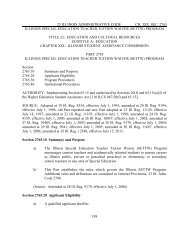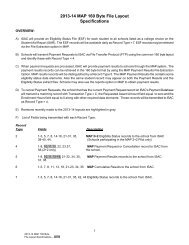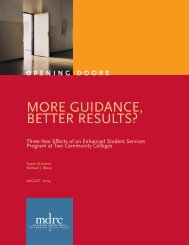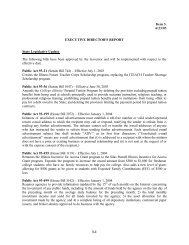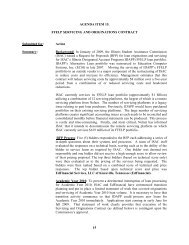High school rigor and good advice: Setting up students to succeed
High school rigor and good advice: Setting up students to succeed
High school rigor and good advice: Setting up students to succeed
You also want an ePaper? Increase the reach of your titles
YUMPU automatically turns print PDFs into web optimized ePapers that Google loves.
colleges report much lower persistence rates because of the sizable number of <strong>students</strong> who transfer<br />
following their first year.<br />
This report aims <strong>to</strong> provide a better underst<strong>and</strong>ing of which <strong>students</strong> are not persisting past their first<br />
year of college, <strong>and</strong> what kinds of fac<strong>to</strong>rs influence this. If state policymakers, post-secondary<br />
institutions, <strong>school</strong> districts, <strong>and</strong> high <strong>school</strong>s can implement policies that increase first <strong>to</strong> second year<br />
persistence, we believe it can dramatically increase the amount of <strong>students</strong> who eventually obtain a<br />
post-secondary degree.<br />
The main findings in this report point <strong>to</strong> the highest level of math in high <strong>school</strong>, taking an AP/IB course,<br />
<strong>and</strong> meeting with college academic advisors as fac<strong>to</strong>rs that can greatly improve the chances that a<br />
student will persist <strong>to</strong> their second year of college. This report separates four-year from two-year<br />
institutions so that we can see the differences in their student populations <strong>and</strong> persistence. After<br />
describing the findings, this report will provide some suggested actions that <strong>school</strong> districts <strong>and</strong><br />
policymakers can take <strong>to</strong> help improve student post-secondary persistence.<br />
Defining the Student Gro<strong>up</strong>s Used in This Study<br />
To better isolate the effects of the high <strong>school</strong><br />
experience we controlled for the socioeconomic<br />
status (SES) <strong>and</strong> prior academic achievement of<br />
the <strong>students</strong>. This allowed us <strong>to</strong> compare<br />
<strong>students</strong> with similar SES levels <strong>and</strong> academic<br />
achievement. Although we could not control<br />
completely for other potential fac<strong>to</strong>rs like student<br />
motivation, this approach still provides a closer<br />
apples <strong>to</strong> apples comparison of the effects of<br />
certain variables. There is a common argument<br />
that <strong>school</strong>s can only do so much <strong>to</strong> help <strong>students</strong><br />
<strong>succeed</strong> because poverty <strong>and</strong> other fac<strong>to</strong>rs<br />
associated with low SES, as well as the level of<br />
academic performance that the student shows<br />
are such determinant fac<strong>to</strong>rs for success. While<br />
it is true that these can be related <strong>to</strong> persistence<br />
in college, this report finds that even after taking<br />
a student’s SES <strong>and</strong> prior achievement in<strong>to</strong><br />
account, strategies emerge that high <strong>school</strong>s can<br />
implement <strong>to</strong> improve persistence.<br />
In order <strong>to</strong> analyze the impact of these high<br />
<strong>school</strong> variables, we gro<strong>up</strong>ed the <strong>students</strong> in this<br />
study in<strong>to</strong> several categories. We looked at<br />
<strong>students</strong> with high SES <strong>and</strong> high prior academic<br />
achievement, those with low SES 3 <strong>and</strong> low prior<br />
academic achievement, <strong>and</strong> those with middle<br />
SES <strong>and</strong> middle prior academic achievement. For<br />
the SES measure we use a definition used by the<br />
Reasoning for Student Gro<strong>up</strong> Rankings<br />
We chose <strong>to</strong> compare <strong>students</strong> between the<br />
21 st <strong>and</strong> 80 th percentiles in both SES <strong>and</strong> 10 th<br />
grade st<strong>and</strong>ardized scores. There are two<br />
reasons for this:<br />
First, the number of four-year institution<br />
<strong>students</strong> in the bot<strong>to</strong>m quartile of SES<br />
<strong>and</strong> achievement is very small.<br />
Conversely, there are not many two-year<br />
institution <strong>students</strong> in the <strong>to</strong>p quintile of<br />
SES <strong>and</strong> achievement. If we used just<br />
the highest <strong>and</strong> lowest ranked <strong>students</strong> it<br />
would not give as accurate a portrayal of<br />
the characteristics of the majority of<br />
college <strong>students</strong>.<br />
Second, the student gro<strong>up</strong>s in this<br />
analysis do not represent the extremes of<br />
SES or academic achievement. Any<br />
differences between the low <strong>and</strong> high<br />
SES/achievement gro<strong>up</strong> is conservative.<br />
Surprisingly, this report did not have <strong>to</strong><br />
compare the extreme <strong>to</strong>p <strong>and</strong> bot<strong>to</strong>m<br />
quintiles of SES/achievement in order <strong>to</strong><br />
show the dramatic differences in<br />
persistence between both gro<strong>up</strong>s.<br />
3



